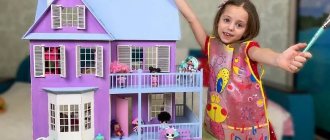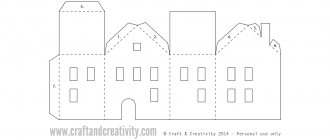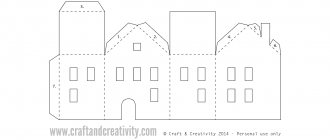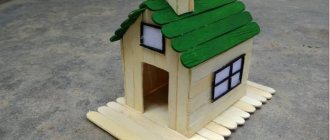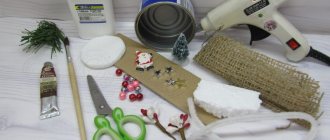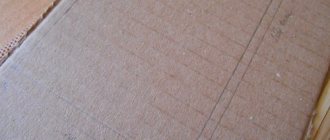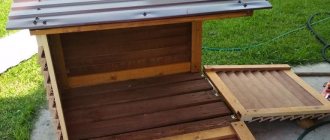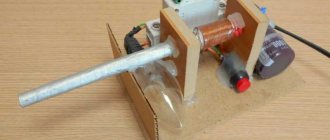Each of us has had or currently has pets that play and frolic at any time and in any place. And there was so much torn furniture, chewed doors and jambs, torn curtains and broken dishes. And in order to avoid these little troubles, it was thought up to combine all of the pet’s favorite entertainment into a single complex. The idea is amazing, but with the growth of fashion for pets, prices for such products began to rise. There's no need to get upset. If you put in a little effort, you can make a wonderful, budget-friendly and original complex for cats with your own hands. Believe me, your cat will appreciate this, and you will also be calmer about the safety of your property.
Peculiarities
The cat house performs several functions:
- shelter - a place where you can hide from the other residents of the house;
- observation point - the pet should be able to view the maximum space around from it;
- a warm, cozy nest where you can sleep or just lie down and soak up;
- play area with scratching post , ribbons, tunnels and other play accessories.
An original house for a cat
Thus, in order to look attractive to cats, the house must be:
- according to the size of the cat - it should fit freely into it and be able to freely curl up into a ball, but it is important not to overdo it with the dimensions;
- consist as much as possible of natural materials - wood, cardboard, natural felt and others (synthetic materials electrify the fur of cats, and this causes discomfort - plastic, artificial fabrics);
- away from equipment and objects that produce loud sounds - away from TV, radio, music center;
- moderately warm, not exposed to drafts - cannot be installed under windows, on a windowsill, close to a radiator, near a door or passage.
IMPORTANT! The ideal option is to arrange a resting place for the cat in the far corner, relative to the entrance to the room or against the wall located opposite from the entrance.
Stylish cat house
The house should be the size of the pet
It is very important not to forget about humidifying the air in rooms where pets are kept. Read our separate article on how to make a humidifier with your own hands. And also, which humidifier is better to choose.
Booth houses
A cozy nest for a cat where she can be alone. Such a building is a full-fledged house with a roof. The stores offer models of different sizes and areas. Some of them include an external or internal scratching post. This practical move on the part of the manufacturers will protect the furniture from the sharp claws of the pet. An important advantage is the beautiful appearance of the booth. If desired, owners of domestic cats will be able to decorate the house with additional safe elements.
What is he like?
A house for a cat must meet all the requirements of a four-legged friend walking on his own. First you need to study the habits of the cat. Perhaps he is quite playful, then he needs to organize special homemade devices for games.
Some cats prefer to sleep, then you should take more care of the resting place. Some cats prefer to sharpen their claws on their owners' furniture , which not only irritates, but also infuriates a person at the sight of damage to expensive property. Homemade scratching posts and cat houses can solve the problem.
Wall complex with scratching posts
So, you have analyzed your cat’s preferences and are now deciding on a design model. This may include:
- Additional “devices” for exercise. Playful cats need a place to burn off their energy. Along with the covered house, install additional poles with tabletops wrapped in twine. Such houses can also be found on sale in specialized stores, but their cost may exceed the permissible family budget. They are easy to make yourself from plywood and other building materials.
- A back door in a cat house is required. The cat can pounce on the enemy, hide in its shelter and change its hiding place using the back door. When in danger, a cat will take out the kittens through an additional move, and then rush at the enemy. This is the nature of cats, you can’t argue with them.
- The dimensions of the cat house should be calculated in advance. If the four-legged pet is of medium size, then it will be enough to make a house with an entrance with a diameter of 15-20 cm, and the dimensions of the “sleeping” place and shelter in the form of a cube with an edge of 40 cm. Next, proceed from the given indicators. The dimensions of additional devices in the form of beds and other utensils should also be selected in accordance with the size of the animal. Standing on its hind legs, the pet should reach with its front legs.
- The use of a scratching post as an additional attribute should also be thoughtful. Firstly, it must be made of durable material that can withstand all the pressure. Secondly, it must be accessible from any corner of the erected structure.
- Study your pet's habits according to the characteristics of its breed. For example, Siamese or Bengal cats love to stand on their hind legs. For them, you should make a wigwam house with a height of at least 60 cm.
It should also be noted that the design of the house may vary significantly depending on the gender of your pet.
For example, cats are more playful and love to hunt, so they should build a building with a large view. Here you can stay at the sleeve house .
Sleeve house for cats
For a cat, it is better to make a two-level design , where the upper level will help look out for the enemy, and the lower level will use the mother of the newly hatched offspring for an ambush, and if danger approaches, she will attack the future offender.
Two-level houses are preferable for cats
Also, you should not allow a large view of the cat's house - she prefers to ensure the safety of her den.
Watch in this video how to make a play complex for a cat with your own hands at home.
Pets bring us a lot of joy and warmth, but wool is an integral part of their presence in the house, so it is important to take care of cleaning the air in the apartment. Read our separate article on which air purifier to choose for your apartment.
Photo
The following photos show various options for making houses for cats.
Using wool felting technique
Wooden summer house
From cardboard
Wigwam
Knitted bed
Hammock for cat
Who would like a cat exercise machine - a running wheel?
Cats, like people, differ in character and temperament: some can spend the whole day on the couch, others need constant movement.
Passive cats play reluctantly, sleep 20–22 hours a day, are calm and slow. Active ones clearly demonstrate the hunting instinct, restlessly rush around the entire apartment, play a lot and noisily, splashing out their energy. In this they differ little from their wild relatives: in nature, such cats can cover a distance of more than 10 km at night in search of food. If every day your pet wakes you up in the morning with noisy running around, joyfully pounces on every new toy, jumps on furniture, then this definitely means that you are the happy owner of an active breed of cat. A running wheel will come in handy in a home where representatives of active breeds such as Siamese, Bengal, Abyssinian, Kurilian Bobtail, Egyptian Mau, Balinese and others live.
Cat in a running wheel
City apartments are cramped for such cats, they limit their hunting territory, so tailed fidgets endlessly run around the house, jump on windows and curtains, damage furniture, causing trouble for the owner. It is especially difficult for pets if the owners do not have the opportunity to take the cat for a walk. Cats may begin to mark their territory at home by running restlessly around the rooms. The simulator will help calm the animal and redirect attention.
The treadmill wheel is very popular in Europe, and this exercise machine has recently appeared on Russian shelves.
Now it can be purchased at any pet store, which allows every owner to take care of the health of their cat, or to make it themselves.
Game complex - step-by-step instructions
a cat house with your own hands from scrap materials. Here you will need a little skill and a little skill. If you are not a master at working with a hammer and nails, you can use simple methods to erect a structure.
Cardboard house
The play complex for cats is especially popular among ordinary people and cat breeders, as well as pet store sellers, because this is where you can find all the variety of housing for animals. Take this opportunity and carefully consider such designs, so that you can then create your own version of the “living space”.
Play complex made of sawn wood
As a rule, the presented type of complexes has a high cost, however, the cost itself does not exceed several hundred rubles. Sometimes the necessary materials are available.
Necessary materials
So, to build this kind of structure you will need the following materials:
- plywood no more than 10 mm thick;
- polyethylene pipe with a diameter of up to 12 cm;
- furniture metal corners in the amount of 15-25 pieces;
- any natural rope, you can take hemp or jute;
- liquid glue without a strong odor;
- any material your pet likes (you can find out by his favorite place to sleep) for lining the house;
- tools for work.
Master class on making a cat house with your own hands:
- Cut 6 squares from plywood in accordance with the size of the future recreation area. In two of them make round holes - the main entrance and the back door.
- Connect the walls of the home together into a kind of cube using furniture corners. Before attaching the part with the main entrance hole, upholster the inside of the house with material. A layer of foam rubber should also be placed under the material. Attach "entrance".
- Use a pipe to create an observation deck. You can first coat it with glue, and then tightly wrap the rope around it.
- Cut out a square or rectangle according to your pet's size to create an observation deck. Cover it also with material, having previously placed foam rubber.
- Attach the viewing platform using corners to the pipe.
- The pipe is attached to the roof of the manufactured house, which can also be pre-upholstered with material on the outside, but without foam rubber.
This house model is the simplest and is used as a basic option. Of course, the owner can improve the housing for his pet in accordance with his preferences . Sometimes an additional play pendant is attached at the bottom of the viewing platform.
This combination option is possible, but only if the entire structure is fixed to the floor, because an unstable house can be turned over during play, which will lead to injuries to the four-legged pet. Think through everything carefully and with the possibility of possible unpleasant incidents.
Selection of materials
A house for a cat, with all the additions, is usually assembled from construction remains. This is completely justified, because many (or even all) surfaces of the finished structure will be covered with fabric, textiles, entangled with ropes, etc. So if you have leftover building materials, you can use them. There are two requirements for materials (all):
- They should not have a pungent odor. At least the kind that the human nose perceives. Natural odors (wood, wool, etc.) do not count. If the material was purchased recently and there is a chemical smell, leave it outside to air it out.
- Materials should not be electrified. Static discharges are very unpleasant for cats, so they do not like open plastic surfaces. Also, don't use silk.
Different designs, but the same materials.
All the requirements, but there are still wishes. Do you want your cat to quickly and actively explore the house? Let the building materials sit in the house for some time. They will be saturated with familiar smells and will be explored by curious animals. A complex made “from materials saved” in the house will be received with greater favor.
Base materials
If you look at the photo, the cat house consists of different parts and they can be made from different materials. The list of basic materials is as follows:
- House (kennel): chipboard, thin boards, twig weaving, newspaper tube weaving;
- Vertical/inclined parts: round - plastic sewer pipe, paper (cardboard) pipe on which linoleum is wound, tree trunk, wooden beam; A cat house can also be made from a tree trunk.
- inclined - boards, chipboard, fabric;
Only the tree trunk, as a material for the cat complex, requires explanation. Everything is literally: take a tree, peel off the bark if it falls off. Use the branches as stands for placing houses, platforms, and baskets.
What to sheathe with
Twisted rope made of natural fibers is suitable for arranging scratching posts: jute, linen, hemp, sisal, etc. Take a thicker one with a diameter of several tens of meters at once - if the base is not wooden, you will have to wrap all the pipes with rope.
Shelves and houses are sheathed with dense material with short pile, usually carpet. The shorter and denser the pile, the better. Long and furry ones only look good, and while they are new, over time they accumulate dust, hair, various debris, and the cat’s home becomes the cause of allergies (yours or the cat’s).
Upholstery/paneling - not too fuzzy
The color of the upholstery is generally unimportant for cats - they do not react to colors. Therefore, you can choose “to match the interior”, the most “practical” color, the color of your pet’s fur, contrasting with the cat’s fur... any.
Fastening
To make your homemade cat house safe, you should think about the fasteners. It is not advisable to use self-tapping screws, since wool can cling to them; you should not use staples either - they can be dangerous for claws (both types of fasteners are suitable if they are covered with upholstery). There are, in fact, only two types of fasteners left: glue and nails, and the glue is only PVA. Cats tolerate it well, as it does not smell after drying. Ropes and upholstery are glued onto it, and shelves, houses and everything else are nailed.
Cat climbing frames with hammocks
You can also make it safe to use self-tapping screws. Drill a hole under the cap with a diameter larger than the diameter of the cap, install fasteners, and cover with putty. Yes, just like when making furniture, but what can you not do for the safety of your pet?
And one more thing: if the cat complex turns out to be too high, it is better to fix it. To the floor or to the wall, or to both the floor and the wall. Otherwise there may be problems - there have been cases when cats collapsed the structure.
From the box
If there is any extra box in the house, you can show your imagination and construct a cardboard house yourself.
To make construction somewhat easier, use a box of suitable sizes so that your pet does not feel cramped in it. You can involve children in the work. They will be interested in feeling like builders.
Cardboard cat house
So, to make a cat house you will need:
- a box with fairly thick cardboard (you can use a Russian Post package);
- carpet or other dense but soft material;
- any water-repellent material;
- sharp knife;
- odorless glue;
- pencils, rulers and other tools for marking;
- wide tape.
Proceed to making a cardboard cat house in the following sequence:
- Mark the main entrance and back door using a pencil and compass. Cut out the holes. Let the main entrance be larger than the back door. But remember that your pet should slide through it easily.
- Tape all edges of the box that open and facilitate disassembly. For greater persuasiveness and protection, you can tape the entire box with tape.
- Further cut pieces of water-repellent material in accordance with the dimensions of the walls of the future house. Carefully bring them in through the “entrance”, lay them out, gradually gluing them to the walls with glue. It is better to use glue for a hot procedure, especially if you have already covered all the walls with tape.
- Separately glue the joints of the assembled box with water-repellent materialto keep your pet warmer.
- Now you can begin the exterior finishing. Cut pieces of carpet according to size. The front wall with the entrance is cut out in one piece, glued and only then, after thorough drying, a hole for the entrance is cut out. The hole is cut with a margin of approximately 1-1.5 cm for bending inward. Cut the edge of the carpet diagonally and glue it, “tucking” it inside the house.
- Let the house dry for at least 3 days. After the time has passed, place a pillow in the house and call the cat to rest.
Such self-production options can be slightly improved and modified. Some people prefer to glue the cardboard to fit their designed structure. There is often a multi-room or multi-level structure, which can be easily achieved with cardboard and tape.
Labyrinth of boxes
Photo with dimensions
No matter how much we talk about the design of a cat house, the best way to understand the dimensions is by drawings with dimensions. If you look at them carefully, you will notice a solid run-up. This is understandable - there are large and small cats, and accordingly the size of the cat's house will be larger/smaller. You can adjust them yourself depending on the size of your pets or the available space.
Photos of cat houses with dimensions
Three options for cat corners with sizes
The height of the presented structures is quite large - 180 cm and above, but you can reduce it by removing floors that you think are unnecessary. All these dimensions can be taken as a basis to develop your own layout and put down approximate dimensions. Having the drawing in hand, you can begin purchasing materials and manufacturing.
From newspaper tubes
Masters of weaving from newspaper tubes create amazing works, not forgetting about their pet. So, with the help of an unnecessary stack of various waste paper, you can create a wonderful structure where your pet will be warm and cozy. The following materials will be required here:
- PVA glue;
- scissors;
- knitting needle;
- a stack of newspapers;
- paints or varnish (optional).
A cat house from newspaper tubes is created as follows:
- Cut the newspaper for blanks into long strips approximately 7-12 cm wide. Wind each strip tightly onto a knitting needle, hooking it on one edge. You will end up with a long newspaper tube, the end of which should be glued with glue so that it does not unravel.
- Weaving begins from the bottom of the future cat house. We make a crosshair in the center, and then gradually turn it into a disk.
- Next, we attach the tubes along the edges, which will hold the main frame of our wicker cat house. First you need to walk along the entire diameter around the bottom to make the sides of the bed.
- In the next step we will raise the cocoon, gradually increasing the mass of tubes on the back wall.
- We don’t touch those vertical newspaper tubes that are already out of use for now - we leave them sticking up. At the final stage, we will braid them into a beautiful braid to beautifully decorate the cat’s house.
- The house can be coated with paint and non-toxic varnish. Be sure to check if the varnish contains any harmful components! Cats often like to have fun with their houses and sometimes chew on straws to sharpen their teeth.
The cat house is ready. You should put a pillow inside to make your pet comfortable.
Watch this video for more details on how to weave a cat house from newspaper tubes.
Preparing hangers and cardboard
In order to use the full length of hangers (for a more spacious house), you can bend the top hook and “unwind” the metal at the point where it passes from the hanger to the top. Mom decided to do it simply - she “bite off” the hooks with pliers.
One of the most beautiful nations: photos of Ossetians from which you can’t take your eyes off
Why hysteria is a stage of development, and how to help your child survive it
How to grow strong tomato seedlings with the right fertilizer?
If you have time and desire, the edges can be additionally filed with a file so that there are no sharp ends. This is reinsurance for owners of kittens or very nimble cats. Our Martha is a calm “lady”, so we skipped that part.
Then we bent the hangers to their full length - turning them into identical, even rods.
A piece of cardboard was cut straight and all corners/edges were covered with thick tape so that the paper would not fray after some time of use.
- You can use insulating tape if you don't have tape.
From foam rubber
A soft house for a cat with your own hands requires special attention. Here you can not only create a comfortable and warm corner for your pet, but also show your imagination with decoration and in the process of designing the house. To make such a soft structure you will need the following materials:
- any dense fabric, you can take contrasting shades;
- foam rubber, preferably thicker, so that the cat feels soft and cozy;
- sewing machine;
- pins and other sewing parts for fastening;
- threads
Soft house for a cat
To sew a house for a cat with your own hands, follow these steps:
- Construct a project for the structure by “sawing” it into its component parts, each of which should be transferred to newspaper or paper - this will be the template for the future pattern.
- Transfer them to fabric and foam. Taking into account allowances of 1-1.5 cm, cut out all the parts: for each pattern there is one part made of foam rubber and two parts made of fabric.
- Place all the parts in the following order: foam rubber, fabric face up on top, fabric face down on top.
- Machine stitch all the edges, leaving the bottom edge to serve as a seam to the floor.
- Turn out all the parts, straighten the corners well and iron the seams.
- “From the inside” of the house, sew all the component elements on a machine; last of all, sew on the floor. Turn out the entire house, giving it the desired shape.
This completes the making of a soft house for your pet. You can experiment with colors by making patterns from distinctive shades.
This video will show you how to make a soft house for a cat.
Wood
Building a wooden cat house with your own hands requires skills in working with wood and other tools. It can be used at home or installed outdoors like regular dog houses. Of course, this needs to be done only in the warm season.
Plywood house
First, you should design the entire structure and make blanks from boards, having previously sanded them.
Some craftsmen make similar houses using wooden slats, which allows them to create quite interesting and somewhat complicated structures. So, you can find an outdoor house for a cat with a staircase, a veranda, a carved roof and other attributes resembling an old Russian hut.
Street house BoxDogRu
The inside of the house is covered with a water-repellent material, and then the outside is treated with a composition that is protective against rot and mold. Here you can treat the entire house with drying oil, varnish, or simply paint it, creating an unsurpassed design.
After all the chemical solutions have evaporated, you can put a pillow on the cat and invite him to a housewarming party.
Wooden cat house
Built into furniture
Enterprising owners can come up with anything they can, and often adapt existing furniture into a cozy pet’s refuge .
The following pieces of furniture can be turned into a cat house:
- a cabinet or small cabinet (bedside), cutting out a passage in the door;
- a sofa by attaching cardboard or fabric tunnels to it, or placing a shelf with a lounger on the side;
- a bookcase with a ladder attached so that the cat could use it to get to the very top and hide there;
- a table or chair with a soft fabric hammock secured under it;
- table, making an additional lower shelf with a lounger, pillow;
- open shelves of cabinets, placing beds or low baskets or boxes on them;
- shelves for flowers, setting aside the bottom shelf for the pet and the top for flowers.
For such transformations you will need simple tools that can be found in any home:
- scissors, needle and thread;
- hammer, nails;
- screwdriver, self-tapping screws;
- jigsaw (manual or electric);
- glue, stapler for furniture.
House for a cat from a chair
Cat shelf
To make it you will need a pine or oak board. It should be cut into shelves of the required size. Next, you should connect all the parts together using self-tapping screws or wood glue and a furniture dowel.
Cat shelf
After the wall structure is assembled, it should be examined again for nicks and irregularities. If necessary, it is recommended to clean them, after which the shelf is varnished.
Setting up the glow strip
The luminous tape is installed along the outer perimeter of the house, and the appropriate settings are made.
LED strip for a cat house
Upholstery of steps
The upholstery on the steps can be secured with special hat nails or a stapler.
Decoration of steps
For your information! A little catnip will allow the owner to attract the attention of his pet to the new design.
cat house
A cat house is a convenient and useful structure not only for the cat, but for other family members. This will allow the owner to forget about the torn wallpaper and sofas and give the cat the opportunity to relax in privacy. If there are children in the house for an animal, this is simply a necessary design.
DIY wigwam
The house in the form of a wigwam looks fresh and provocative . At home, you can quickly and easily build it from cardboard or fabric.
Wigwam for a cat made of cardboard
The following materials will be required:
- 6 twigs or branches - the basis of the frame. The upper ends are fastened together, the lower parts are widely spaced in different directions for stability.
- Scotch tape or rope - to secure the rods.
- Cardboard is the bottom of the wigwam. A hexagon is cut out and covered with fabric (preferably water-repellent).
- Glue or needle and thread - for holding fabric together.
- The fabric is cut into 6 isosceles triangles, in one of which a slot is made for the entrance.
The parts of the material are sewn together in such a way that rods can be inserted into the seam between the pieces of fabric. The frame is inserted into the stitched tent, and the bottom edges of the material are sewn to the bottom of the cardboard base.
Wigwam for cats made of fabric
scratching post
A scratching post is an important and necessary attribute; it should be used from the first days of a pet’s appearance in the house.
It will keep furniture and walls intact. By sharpening its claws, the pet thereby processes them and keeps them in full combat readiness.
Cat scratching posts
REFERENCE. Claw point is also associated with play and stress relief through physical activity.
And in this video you can see one of the ways to make a scratching post for a cat with your own hands.
Bed
A cat bed can be made of cardboard, newspaper tubes, or foam rubber. The shape of this resting place is selected in accordance with the size of the cat or its preferences in relaxation.
Cat bed made from an old sweater
Some prepare beds similar to the existing interior in the apartment. The main thing in this matter is to provide your pet with comfort and warmth. Therefore, do not forget about using foam rubber, soft fabric and other textile materials.
Soft fabric bed
For a kitten
A house for a kitten is just as necessary as for an adult cat. Here it is better to build a real play complex , if possible supplementing it with soft attributes - a place to relax and spend the night.
You can also build a regular sleeve house , which is attached to the wall at a small height from the floor so that the kitten can climb into it on its own.
Sleeve house for a kitten
It is better not to use large-sized and labor-intensive wooden structures.
Firstly, a house for a kitten should not be “for growth” . Otherwise, the little cub will not show interest in it, because it will be uncomfortable for him.
Secondly, in just a few months you will have to build a new house, which requires a lot of effort and time. Here it is better to give preference to weaving their newspaper tubes or cardboard blanks.
The first home for kittens is usually a large box in which they are born and kept for the first month of life.
A simple house for a kitten out of a box
The instructions for creating a house for a kitten contain the following steps:
- take a cardboard box , for example, from a vacuum cleaner or microwave, the main thing is that it is high enough so that the kittens do not jump out of it;
- cover the bottom with water-repellent material , for example, oilcloth and fabric, or ordinary baby absorbent diapers, since the baby has yet to learn how to walk in the tray;
- if his mother also lives with the kitten, then an entrance is cut into the house for her , at such a height that the baby cannot jump to it;
- make a roof - from fabric or cardboard (just secure it with stationery clips).
Another option for the first shelter can be a shoebox - a small pet will love to sleep and hide in it. It will serve until the baby grows up. The bottom is covered with a soft cloth, the lid does not close.
The next resting place could be a soft bed or pillow .
Soft bed for a kitten
The main difference between a children's house and an adult one is its small size and short service life , firstly, because the animal is growing, and secondly, kittens do not yet know how to go to the toilet in a litter tray, which leads to the unusability of the same cardboard.
House for a kitten from an old suitcase
Do not forget to take care of the absence of drafts, which are so dangerous for the baby, especially in the cold season. In our separate article, we will tell you how to adjust plastic windows for the winter.
Benefits of a running wheel
A treadmill is similar to a human treadmill. It helps the cat lose excess weight, strengthen the cardiovascular system, muscles, and lungs.
The wheel will be useful for overweight cats and will help them get into good physical shape. Spayed and neutered cats are most susceptible to overeating. As in humans, this can lead to serious heart disease, metabolic disorders, and stress on internal organs and joints.
Together with proper nutrition, such a simulator will allow your cat to stay healthy and lose extra pounds.
The simulator can replace a scratching post. The inner covering is made in such a way that the cat can rest on it with its paws. The animal will use the running wheel when it is bored or the owner is not at home. If there are several cats in a family, then the simulator will be an excellent play complex for them.
Running on a wheel allows your cat to burn off some energy.


